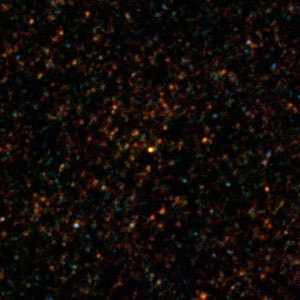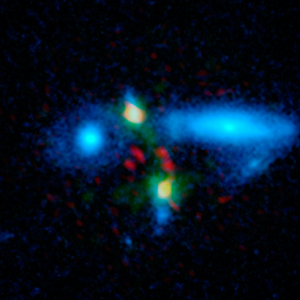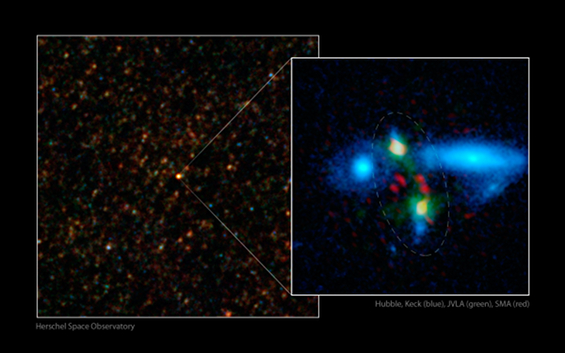Rare merger illuminates origin of 'red and dead' galaxies
22 May 2013
Astronomers have found a rare encounter between two massive and gas-rich galaxies in a survey from Herschel. The event took place when the Universe was only about three billion years old and involved two galaxies forming stars with exceptional efficiency whilst in the process of merging. This galactic collision would go on to form a very massive elliptical galaxy with hardly any star formation activity. The discovery suggests a viable mechanism for the origin of the puzzling 'red and dead' galaxies that are seen in the young Universe.Most massive galaxies in the Universe fall into two major categories: gas-rich spirals that are actively forming stars, and gas-poor ellipticals, populated by old, red stars and with little or no ongoing star formation. Astronomers have been investigating for decades how these two different types of galaxies came into being and whether spirals may be the progenitors of ellipticals via galactic mergers.
A puzzling discovery made in the past decade was that of 'red and dead' galaxies in the young Universe: very massive and passive ellipticals found at redshifts between 2 and 1.5, corresponding to epochs in cosmic history when the Universe was three to almost five billion years old, or only about one third of its present age. Somehow, on a short cosmological timescale, these galaxies managed to exhaust their gas reservoir and consequently stopped forming stars: this left them with stellar populations that had already aged enough to appear red and old.
A new study based on data from ESA's Herschel Space Observatory has discovered a rare snapshot of when two massive, gas-rich and actively star-forming galaxies were merging into an extremely massive elliptical galaxy. The result, published in the journal Nature, suggests that a merger between gas-rich galaxies is an effective mechanism to form the most massive elliptical galaxies known, even when the Universe was quite young.
"This system of interacting galaxies is truly exceptional," comments Hai Fu from University of California, Irvine, USA, who led the study. "It's unusual not only due to the high mass and intense star-forming activity of the two galaxies involved, but also because it exposes a crucial, intermediate step of the formation process. Such starbursting galaxies have very short lifetimes – in cosmological terms – so seeing a pair 'in action' is extremely rare and valuable to constrain models for the formation and evolution of galaxies."
 |
|
Herschel's view of the bright source HXMM01. |
The source, named HXMM01, was originally detected as an unusually bright object in the HerMES project, a large survey compiled with Herschel aimed at investigating galactic evolution in the distant Universe. With a redshift of about 2.3, HXMM01 dates back to the epoch when the Universe was barely three billion years old.
"We were concerned that HXMM01's intense brightness at sub-millimetre wavelengths might be due to gravitational lensing – the bending of light caused by foreground massive objects. In some cases, that can strongly magnify the appearance of a background galaxy," explains co-author Asantha Cooray, also from University of California, Irvine, USA.
Previous studies based on Herschel data have revealed a handful of high-redshift galaxies whose flux is greatly amplified via gravitational lensing. In those cases, the boosting effect made the detection easier for the astronomers.
"But we discovered that gravitational lensing is not the reason for HXMM01's extreme brightness. The source really is very bright because it consists of two intrinsically bright galaxies in the process of merging," says Cooray.
The astronomers conducted extensive follow-up observations across the electromagnetic spectrum, from radio and sub-millimetre wavelengths to the near-infrared and optical domain. These data provided a higher resolution view of HXMM01, revealing two separate sources, which are two physically distinct galaxies lying at redshift 2.310 and 2.307 respectively.
 |
|
Multi-wavelength view of the merging galaxy pair HXMM01. Credit: ESA/NASA/JPL-Caltech/UC Irvine/STScI/Keck/NRAO/SAO |
By proving that the two sources are at slightly different distances from us, the astronomers were certain that strong gravitational lensing was not affecting their findings either through causing multiple images, or excessively boosting the flux of the source. Two foreground galaxies, at redshifts of 0.502 and 0.655, were also detected in the same field, but they only exert weak gravitational lensing on the merging system in the background.
"We estimate that the two galaxies are about 65,000 light years apart, which is a typical separation for pairs of interacting galaxies," explains Fu. "We also see a bridge of gas connecting the two galaxies in the radio data, which is comparable with similar features that we see in merging galaxies in the local Universe."
Each of the two galaxies has a stellar mass of about 100 billion solar masses, and they each contain roughly the same amount of gas. The astronomers estimated that the merging process would take at most 200 million years to complete, resulting in a massive elliptical galaxy of about 400 billion solar masses.
"We see these two galaxies forming stars at a phenomenal rate – about 2000 stars like the Sun per year – and the conversion of gas into stars is more efficient than in normal galaxies by an order of magnitude," says Fu.
Such a high star-formation rate, spurred by the merger process itself, is not sustainable and would not take long to exhaust the gas reservoir of both progenitor galaxies and quench star formation. The astronomers believe that such a merger must have produced a descendant galaxy with passive star-forming activity and a stellar population of old and red stars.
"We were very lucky to catch this extreme system in such a critical transitional phase. It shows that the merger of gas-rich and actively star forming galaxies is a possible mechanism to form the most massive ellipticals that are observed in the young Universe," comments Seb Oliver from University of Sussex, UK, and Principal Investigator of the HerMES Key Programme, within which the data have been collected.
There are expected to be similar systems of interacting galaxies at comparable redshifts distributed sparsely across the sky – about one every 100 square degrees. It is possible that a few more will be found in the examination of Herschel data, but the likelihood of finding galaxies on the brink of merging, as in this case, is not very high.
"This discovery highlights the importance of the vast surveys that were completed with Herschel," comments Göran Pilbratt, Herschel Project Scientist at ESA. "Scanning large portions of the sky is crucial to finding exceptional sources like HXMM01, which may provide the solution to the riddle of how very massive elliptical galaxies could form when the Universe was still young."
Notes for editors
The study presented here is based on observations performed with ESA's Herschel Space Observatory as part of the Herschel Multi-tiered Extragalactic Survey (HerMES). HerMES is a Herschel Guaranteed Time Key Programme designed to probe galaxy evolution at high redshift.
The source HXMM01 was initially detected in observations performed with the Spectral and Photometric Imaging Receiver (SPIRE) on board Herschel as part of the HerMES survey of the XMM-LSS field. Additional data from the Photodetector Array Camera and Spectrometer (PACS) on board Herschel were also used. Due to its unusually high flux at 500 microns, HXMM01 was identified as a strong gravitational lensing candidate. Follow-up observations revealed that the source is not subject to strong lensing but consists of two distinct, massive galaxies that are undergoing a merger; the two galaxies lie at redshifts of 2.310 and 2.307, respectively. Two foreground galaxies, lying at redshifts of 0.502 and 0.655, were also detected in the same field, but they only exert a weak gravitational lensing effect on the two merging galaxies in the background.
Follow-up observations were performed with: the W. M. Keck Observatory and the Submillimeter Array (SMA) at Mauna Kea, Hawai'i; NRAO's Karl G. Jansky Very Large Array and Robert C. Byrd Green Bank Telescope; the NASA/ESA Hubble Space Telescope; the William Herschel Telescope at La Palma, Spain; the IRAM/Plateau de Bure Interferometer (PdBI); the Max-Planck Millimetre Bolometer 2 (MAMBO2) at the IRAM 30m telescope; the Combined Array for Research in Millimeter-wave Astronomy (CARMA).
In addition, the astronomers also used archival data from a variety of space-borne and ground-based facilities: ESA's XMM-Newton X-ray Observatory; NASA's Galaxy Evolution Explorer (GALEX), Spitzer Space Telescope and Wide-field Infrared Survey Explorer (WISE); the Canada-France-Hawaii Telescope Legacy Survey (CFHTLS); the Faint Images of the Radio Sky at Twenty-Centimeters (FIRST) survey of NRAO's Very Large Array (VLA).
Herschel is an ESA space observatory with science instruments provided by European-led Principal Investigator consortia and with important participation from NASA.
The PACS instrument contains an imaging photometer (camera) and an imaging spectrometer. The camera operates in three bands centred on 70, 100, and 160 μm, respectively, and the spectrometer covers the wavelength range between 51 and 220 μm. PACS has been developed by a consortium of institutes led by MPE (Germany) and including UVIE (Austria); KU Leuven, CSL, IMEC (Belgium); CEA, LAM (France); MPIA (Germany); INAF-IFSI/OAA/OAP/OAT, LENS, SISSA (Italy); IAC (Spain). This development has been supported by the funding agencies BMVIT (Austria), ESA-PRODEX (Belgium), CEA/CNES (France), DLR (Germany), ASI/INAF (Italy), and CICYT/MCYT (Spain).
The SPIRE instrument contains an imaging photometer (camera) and an imaging spectrometer. The camera operates in three wavelength bands centred on 250, 350 and 500 µm, and so can make images of the sky simultaneously in three sub-millimetre colours; the spectrometer covers the wavelength range between 194 and 671 μm. SPIRE has been developed by a consortium of institutes led by Cardiff Univ. (UK) and including Univ. Lethbridge (Canada); NAOC (China); CEA, LAM (France); IFSI, Univ. Padua (Italy); IAC (Spain); Stockholm Observatory (Sweden); Imperial College London, RAL, UCL-MSSL, UKATC, Univ. Sussex (UK); Caltech, JPL, NHSC, Univ. Colorado (USA). This development has been supported by national funding agencies: CSA (Canada); NAOC (China); CEA, CNES, CNRS (France); ASI (Italy); MCINN (Spain); SNSB (Sweden); STFC (UK); and NASA (USA).
Herschel was launched on 14 May 2009 and completed science observations on 29 April 2013.
Related publications
Hai Fu, et al., "The rapid assembly of an elliptical galaxy of 400 billion solar masses at a redshift of 2.3", 2013, Nature. DOI: 10.1038/nature12184
Contacts
Hai Fu
University of California, Irvine
California, USA
Email: haif![]() uci.edu
uci.edu
Asantha Cooray
University of California, Irvine
California, USA
Email: acooray![]() uci.edu
uci.edu
Phone: +1-626-395-4282
Seb Oliver
Principal Investigator of the HerMES Key Programme
University of Sussex, United Kingdom
Email: S.Oliver![]() sussex.ac.uk
sussex.ac.uk
Phone: +44-797-101-9161
Göran Pilbratt
Herschel Project Scientist
Research and Scientific Support Department
Science and Robotic Exploration Directorate
ESA, The Netherlands
Email: gpilbratt![]() rssd.esa.int
rssd.esa.int
Phone: +31-71-565-3621




